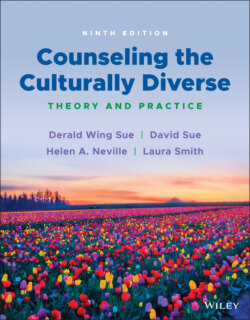Читать книгу Counseling the Culturally Diverse - Laura Smith L. - Страница 111
THE DYNAMICS AND DILEMMAS OF MICROAGGRESSIONS
ОглавлениеThe study of microaggressions presents “a complex scientific challenge because it deals with both explicit and implicit bias; explores the lived realities of marginalized groups in our society; frames microaggressive dynamics as an interaction between perpetrator, target, and the external environment; pushes powerful emotional buttons in the actors; and is difficult to separate from the sociopolitical dimensions of oppression, power, and privilege” (Sue, 2017, p. 171). Not only does the subtle and insidious nature of racial microaggressions render them outside the level of awareness of their perpetrators, but recipients also find their ambiguity difficult to handle. Victims are placed in an unenviable position of questioning not only the perpetrators, but themselves as well (e.g., “Did I misread what happened?”). Victims often replay an incident over and over again to try to understand its meaning.
Yet, despite attribution ambiguity, microaggressions significantly shape experiences and environments. Researchers have consistently identified microaggressions as creating a hostile and invalidating campus climate (Yosso, Smith, Ceja, & Solorzano, 2009; Young & Anderson, 2019), even referring to them as “toxic rain” that corrodes the educational experience of students of color (Suarez‐Orozco et al., 2015).” The cumulative effect of microaggressions has been shown to impede learning by depleting cognitive and psychological resources (Smith, Hung, & Franklin, 2011; Watkins, Labarrie, & Appio, 2010), resulting in a phenomenon labeled “racial battle fatigue” (Martin, 2019). In work that looks extensively at Black males’ experiences at PWIs, Harper (2013, p. 189) refers to this same concept as “onlyness,” defined as the “psychoemotional burden of having to strategically navigate a racially politicized space occupied by few peers, role models, and guardians from one's same racial or ethnic group.”
Microaggressions subject marginalized group members to four major social psychological dilemmas that serve to deplete their psychic energies and create constant stress in their lives (Sue & Spanierman, 2020). Let us use the examples of Jaylen and Melanie to illustrate these challenges.
